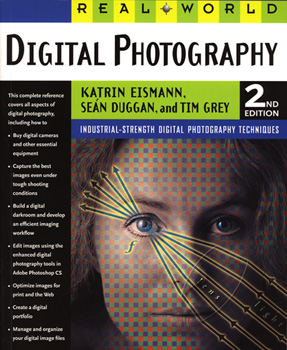"The Rush to New Technology"
***
 |
Tornado Pedro Meyer © 2004 |
|
|
One of the fascinating aspects of what is going on at present in this ever changing landscape of photography is that we are moving both forward and backward at the same time. The improvements of what all these new technologies have to offer, certainly do not bring only benefits. I am obviously a great enthusiast for using and exploring all that the digital revolution has been able to bring us, but I am also quite critical of those matters that hold us back needlessly and dissipate our limited resources for no good reason at all.
One such instance of moving both forward and backward at the same time, is what has just happened with the new Nikon D70 camera, released just a few days ago on March 26th. This is a totally new camera that is cheaper than previous models while sacrificing very little, and offering a slew of very worthwhile improvements especially in the speed of operation. All of which is to be appreciated for sure. But when you go and spend more than a thousand dollars for a new camera (just the body with no lens) you would expect such a camera to be compatible with the basic digital tools that photographers have been using before, namely Photoshop. Or contrary to that, bring to the attention of the consumer who is about to make such an investment, that the RAW file format that this new camera produces is a different one to any previous Nikon model, and therefore still incompatible with all other software in the market other than Nikon's own proprietary offerings. Why should I have to spend additional money to buy their software just because of this incompatibility? I am going on the assumption that most photographers will want to shoot in RAW file format given the noticeable benefits over other formats (more about that later). Unfortunately the D 70 Raw file format is at present incompatible with other software other than Nikon's. You can't even download to your computer with anything other than Nikon software without corrupting those files, unless you do so directly from the memory card. But having to purchase in addition to your Photoshop software the Nikon Capture software, just because it is incompatible at present seems to me unfair, given that the consumer is not given any warning about these present incompatibilities. In time I am sure these issues will be resolved, but why do I need to wait three or four months to get back to my normal work flow, for Nikon to resolve something that should have been functional from the outset? Why do I need to invest in additional software from Nikon if I can use the software I already own? Sorry Nikon, you got this one all wrong and you should make the consumers know when you change the specs on a file format making it incompatible with anything that preceded it.
The picture of this months' cover in ZoneZero was taken from my car with the Nikon camera and a lensbaby. While at the i3Forum, my good friend Dan Burkholder was playing around with a new lens on his digital camera, a lens called the "lensbaby". I could not believe what I was looking at. Here he was using a lens very much like an old fashioned bellows camera and an up-tight tilt-shift lens, providing the look created by the Holga camera, but produced with a digital camera. These lenses fit all Nikon and Canon cameras with interchangeable lens possibilities, and they cost less than one hundred dollars. You can visit lensbabies.com and see for yourself. Dan was generous enough to sell me his own lens, as I was leaving the country the next day and I was not going to have the opportunity to get one in time to write up a report for you as I am doing now. So thank you Dan... (we are looking forward to your images for a Gallery of your work, very soon!). Can you see how we move backwards and forwards in dealing with these new technologies? In some ways aesthetics are retro and technologies are avant-garde. This is where we have to question ourselves how much we can tilt forward to fully benefit from technology. The image on the cover for instance. I never would have been able to achieve it without having access to all the tools in my digital set up. The file was a RAW file which ended up becoming a 100 megabyte file, enough to make a huge print. The manipulation of the colors and shadows was the result of enhancing the information that the camera was able to capture, but above all else, I was able to see while I was taking the picture, that I got what I wanted. The benefit of having a constant feedback on the creative process is something that has not been written about enough.
The growth of photography through cell (or mobile) phones has continued, as we reported to you a year ago. The total number of cameras sold worldwide, be they either digital or analog, was less than the total number of cameras that were incorporated as part of cell phones, as we were told by Evan Nisselson and Bob Goldstein at the i3Forum. This ought to give us some pause for consideration as to where all those images being produced with cell phones cameras are going to end up being published. The phenomenon is wide spread and therefore we are led to believe that it is time to open up a new section in ZoneZero which is called ZoneZero MOBLOGS. Here we will publish your cell phone pictures. You can find out more information about this by going to: Our friends from Textamerica.com, which was founded by Chris Hoar, is providing us with the technology to enable us to do provide you in turn with this service. What we found particularly interesting with this new direction of photography by cell phones is their ubiquitous nature, and how already in major events, there are hundreds of people sending in their images from all directions. What this will do in time is to provide photography with a new possibility for corroboration of content as never before. No longer is a photograph is to be trusted just because it is a photograph, but because in fact the event can be confirmed with images taken from all sorts of angles, therefore providing a new opportunity for photography to have an element of reliability as seldom before. This is particularly important at a time when photographs are not really trusted anymore. Observe the cover of the magazine with the widest circulation in Mexico, TVyNovelas, where they actually have to state, "Esta foto es real" ( this picture is real). Imagine this being questioned just a few years back.
You really do not wish to miss out on using this new file format. It transforms the nature of how we approach photography. It used to be that everything was set in stone the moment the shutter was clicked... for good or for worse, one would have to live with those results. Now all of a sudden life has been extended, and what happens at the time of clicking the shutter on your lens, is no longer the definitive and ever lasting truth. You have all sorts of new opportunities to reset exposure, and all the lighting conditions that you had chosen, even white balance. This is not the place to enter into all the technical specs of how the RAW format works, but let me point out that the direction of this technology is one of the most exciting things that I have seen in years. Of course not everything is perfect, one of the draw backs -as you could observe at the beginning of this editorial- is that there is no universal standard for this file format yet. This is not good for the consumer, as all those files that are now being shot in a RAW format will have to be updated in the future, so that those files will be accessible over time. When a standard is proprietary to one company, such as is the case of Nikon, we have to cast some reasonable doubt that they will in fact be guaranteeing that their file format will always be upgraded so that it can be read with software that is going to be used ten or twenty years from now. If we can not get them to be forthcoming with information that their file format is incompatible at present with other software, now that they came out with the new D70, I have my strong doubts about their sense of duty towards the consumers years from now. They have yet to prove that this is the case, we can not take them for granted. Ask (or complain) and you will receive... raw support for the D70, and others/CS http://www.adobe.com/support/downloads/detail.jsp?ftpID=2461
At a time when there is a plethora of books offering technical information for the photographer wishing to gain access to what is going on in digital photography one book stands out for the wealth of information and the simplicity with which such knowledge is transmitted. I don't think that even professionals with experience can go through this book without finding a diversity of very useful and important information. Written by Katrin Eisman, Sean Duggan and Tim Grey, this book deserves to be on your shelf right next to your computer regardless if you are a working photographer, a teacher, or an art critic (especially the latter ones, who many times do not have a clue of what they are writing about). Unfortunately this book is not yet translated to Spanish or other languages, we hope this will happen soon. We hope that this extended Editorial will create a lot of very interesting feedback on our forums.
Pedro Meyer Please share your comments on this issue with us in our forums.
|
|




